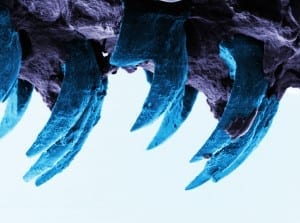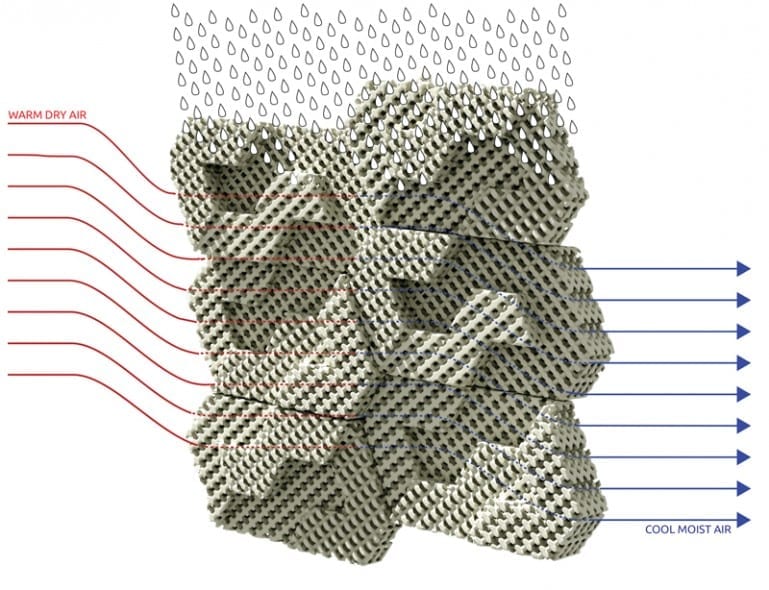
Limpet teeth might be the strongest natural material known to man, a new study has found.
Researchers from the University of Portsmouth have discovered that limpets – small aquatic snail-like creatures with conical shells – have teeth with biological structures so strong they could be copied to make cars, boats and planes of the future.
The study examined the small-scale mechanical behaviour of teeth from limpets using atomic force microscopy, a method used to pull apart materials all the way down to the level of the atom.
Professor Asa Barber from the University’s School of Engineering led the study. He said: “Nature is a wonderful source of inspiration for structures that have excellent mechanical properties. All the things we observe around us, such as trees, the shells of sea creatures and the limpet teeth studied in this work, have evolved to be effective at what they do.
“Until now we thought that spider silk was the strongest biological material because of its super-strength and potential applications in everything from bullet-proof vests to computer electronics but now we have discovered that limpet teeth exhibit a strength that is potentially higher.”
Professor Barber found that the teeth contain a hard mineral known as goethite, which forms in the limpet as it grows.
He said: “Limpets need high strength teeth to rasp over rock surfaces and remove algae for feeding when the tide is in. We discovered that the fibres of goethite are just the right size to make up a resilient composite structure.
“This discovery means that the fibrous structures found in limpet teeth could be mimicked and used in high-performance engineering applications such as Formula 1 racing cars, the hulls of boats and aircraft structures.
“Engineers are always interested in making these structures stronger to improve their performance or lighter so they use less material.”
The research also discovered that limpet teeth are the same strength no matter what the size.
“Generally a big structure has lots of flaws and can break more easily than a smaller structure, which has fewer flaws and is stronger. The problem is that most structures have to be fairly big so they’re weaker than we would like. Limpet teeth break this rule as their strength is the same no matter what the size.”
Read more: Scientists find strongest natural material
The Latest on: Bioinspiration
[google_news title=”” keyword=”Bioinspiration” num_posts=”10″ blurb_length=”0″ show_thumb=”left”]
via Google News
The Latest on: Bioinspiration
- ETH Zurich’s wheeled-legged robot masters urban terrain autonomouslyon April 24, 2024 at 12:00 pm
ETH Zurich researchers use advanced learning methods to create an autonomous wheeled-legged robot's control system.
- 5 Stunning Photos That Demonstrate Why Fish Are Often Found In Groupson April 21, 2024 at 5:15 am
Contrary to popular belief, schools and shoals aren’t interchangeable terms. While schools refer to groups of fish that swim in a highly synchronized and organized manner, often in the same direction ...
- Bioinspiration: how nature is helping us innovateon April 16, 2024 at 2:53 am
Nowadays, it is in a slightly different way. Bioinspiration is where biologists study animals to understand the basic principles of their existence, and then bioengineers use this information to ...
- What’s quieter than a fish? A school of themon April 9, 2024 at 3:01 am
The work is newly published in Bioinspiration & Biomimetics. The team created a 3D model based on the common mackerel to simulate different numbers of fish swimming, changing up their formations ...
- What's quieter than a fish? A school of themon April 8, 2024 at 5:00 pm
The work is newly published in Bioinspiration & Biomimetics. The team created a 3D model based on the common mackerel to simulate different numbers of fish swimming, changing up their formations, how ...
- Study finds schools of fish can make less noise than a solitary swimmeron April 8, 2024 at 5:00 pm
The work is published in Bioinspiration & Biomimetics. The team created a 3D model based on the common mackerel to simulate different numbers of fish swimming, changing up their formations ...
- What's quieter than a fish? A school of themon April 8, 2024 at 5:00 pm
The work is newly published in Bioinspiration & Biomimetics. The team created a 3D model based on the common mackerel to simulate different numbers of fish swimming, changing up their formations ...
- Using suction cups inspired by fish to listen in on whale conversationson March 25, 2024 at 5:00 pm
The research is published in Bioinspiration & Biomimetics. Nature offers many different examples of suction discs, from the round suckers used by octopus to the full-body, peanut-shaped discs foun ...
- Darren Beckon May 3, 2022 at 11:43 pm
Topics that are sure to spur his interest include disruptive innovation, advances in technology, the regenerative economy, social justice, co-creating educational experiences, bioinspiration, ...
- Soft Robotic Jellyfish Get Pumped In The Atlanticon October 6, 2018 at 12:32 am
In a recent paper in Bioinspiration & Biomimetics, researchers at Florida Atlantic University describe the process of building and testing five free-swimming soft robotic jellyfish. The paper ...
via Bing News










